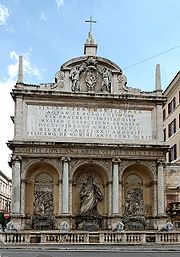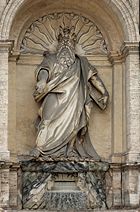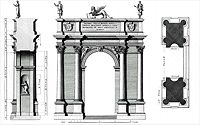
Acqua Felice
Encyclopedia


Pope Sixtus V
Pope Sixtus V , born Felice Peretti di Montalto, was Pope from 1585 to 1590.-Early life:The chronicler Andrija Zmajević states that Felice's family originated from modern-day Montenegro...
, whose birth name, which he never fully abandoned, was Felice Peretti. The first new aqueduct of Early Modern Rome, its source is at the springs at Pantano Borghese, off Via Casilina. Its length is fifteen miles (24 km), running underground for eight miles (13 km) from its source, first in the channel of Aqua Alexandrina, then alternating on the arches of the Aqua Claudia
Aqua Claudia
Aqua Claudia was an aqueduct of ancient Rome that, like the Anio Novus, was begun by emperor Caligula in 38 AD and completed by Emperor Claudius in 52 AD. Its main springs, the Caeruleus and Curtius, were situated 300 paces to the left of the thirty-eighth milestone of the Via Sublacensis...
and the Aqua Marcia
Aqua Marcia
The Aqua Marcia was the longest of the 11 aqueducts that supplied the city of ancient Rome. The still-functioning Acqua Felice from 1586 runs on long stretches along the route of the Aqua Marcia....
for seven miles (11 km) to its terminus at the Fontana dell'Acqua Felice
Fontana dell'Acqua Felice
240px|thumb|Fontana dell'Acqua FeliceThe Fontana dell'Acqua Felice, also called the Fountain of Moses, is a monumental fountain located in the Quirinal eDistrict of Rome, Italy. It marked the terminus of the Acqua Felice aqueduct restored by Pope Sixtus V...
on the Quirinal Hill
Quirinal Hill
The Quirinal Hill is one of the Seven Hills of Rome, at the north-east of the city center. It is the location of the official residence of the Italian Head of State, who resides in the Quirinal Palace; by metonymy "the Quirinal" has come to stand for the Italian President.- History :It was...
, standing to one side of the Strada Pia, so as to form a piazza
Piazza
A piazza is a city square in Italy, Malta, along the Dalmatian coast and in surrounding regions. The term is roughly equivalent to the Spanish plaza...
in this new part of Rome. The engineer was Giovanni Fontana
Giovanni Fontana (Dominican)
Giovanni Fontana was a Dominican friar and late-Mannerist architect, as well as brother of Domenico Fontana.-External links:*...
, brother of Sixtus' engineer-architect Domenico Fontana
Domenico Fontana
Domenico Fontana was a Swiss-born Italian architect of the late Renaissance.-Biography:200px|thumb|Fountain of Moses in Rome....
, who recorded that the very day the new pope entered the Lateran, he decided that he would bring water once again to the healthful hills of Rome, which had remained waterless and sparsely inhabited, largely by monasteries, since the Roman aqueducts had been destroyed in the sixth century. From the source, which Sixtus purchased, there was only a very small fall, and the work required an underground conduit as well as an aqueduct carried on arches. The work was completed within eighteen months, at the same time that Sixtus was engaged in laying out the street plan that would provide the arteries of modern Rome. By October 1586, water was running at his Villa Montalto, and by 1589 it was filling no less than twenty-seven public fountains.

Fontana dell'Acqua Felice
240px|thumb|Fontana dell'Acqua FeliceThe Fontana dell'Acqua Felice, also called the Fountain of Moses, is a monumental fountain located in the Quirinal eDistrict of Rome, Italy. It marked the terminus of the Acqua Felice aqueduct restored by Pope Sixtus V...
(designed by Domenico Fontana
Domenico Fontana
Domenico Fontana was a Swiss-born Italian architect of the late Renaissance.-Biography:200px|thumb|Fountain of Moses in Rome....
, 1587) marked the entry of the new water source into Rome, with the conventional mostra or showy terminus: "what makes a fountain a mostra is not essentially its size or splendor, but its specific designation as the fountain that is a public memorial to the whole achievement of the aqueduct." "Even in the seventeenth century this fountain was considered as being in very bad style (pessimo stile)," Siegfried Giedion reported "and it is scarcely conceivable that such mediocrity was possible only two decades after the death of Michelangelo
Michelangelo
Michelangelo di Lodovico Buonarroti Simoni , commonly known as Michelangelo, was an Italian Renaissance painter, sculptor, architect, poet, and engineer who exerted an unparalleled influence on the development of Western art...
". Its disproportionately large attic, a billboard for the triumphant inscription, has an unbalanced stagey flatness; its proportions may be unfavorably compared to the Arco Scalette, Vicenza, erected in 1576, probably designed by Andrea Palladio
Andrea Palladio
Andrea Palladio was an architect active in the Republic of Venice. Palladio, influenced by Roman and Greek architecture, primarily by Vitruvius, is widely considered the most influential individual in the history of Western architecture...
(illustration, right).

Basilica
The Latin word basilica , was originally used to describe a Roman public building, usually located in the forum of a Roman town. Public basilicas began to appear in Hellenistic cities in the 2nd century BC.The term was also applied to buildings used for religious purposes...
s. Any mostra had its practical aspect in providing public water supply for its rione
Rione
Rione is the name given to a ward in several Italian cities, the best-known of which is Rome. Unlike a quartiere, a rione is usually an official administrative subdivision...
(the city's administrative areas). The marble basins, flanked by Egyptian lions that spit water, served as reservoirs for local inhabitants; marble barriers keep animals from polluting the water: for them there is a special basin nearby. Next to the fountain Sixtus installed two long basins for washing laundry, and a covered washhouse where women might enjoy privacy.
Further reading
- Tani, A.D. 1926. Le Acque e le Fontane di Roma (Rome), p 49ff
- Morton, H.V., 966. The Waters of Rome (London: The Connoisseur and Michael Joseph) 1966
External links
- Aquae Urbis Romae: the Waters of the City of Rome, Katherine W. Rinne
- Roberto Piperno: Acqua Felice and Roberto Piperno, "A few words on Roman inscriptions- II" Illustrates the Latin inscription on the mostra, or inscription panel
- Fontana del Moise

